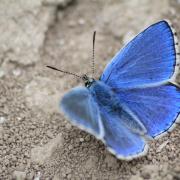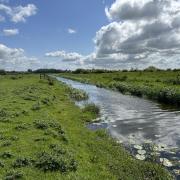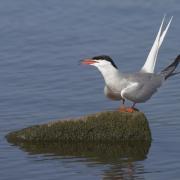An alien invasion may sound like something from science fiction but the truth is out there, in our gardens and our countryside. Laura George, from Cheshire Wildlife Trust, reports on the growing problem of invasive non-native species and what you can do to stop them
Non-native plants (also known as ‘alien’ species) have arrived in the UK by various means at different points in our history. The Romans brought us roses, damsons and nettles, to name but a few, while early American explorers brought back potatoes, tomatoes and sunflowers. The intrepid plant hunters of the Victorian age introduced many of our favourite garden plants such as geraniums, camellias and the flowering currant, as well as a stunning array of orchids and lilies. It was a dangerous profession – many were injured and fatalities were not uncommon in the race to find the most desirable species and strike it rich at the auction house.
Most ‘alien’ species have in time either learnt to grow harmoniously alongside our British flora, causing no significant issues, or simply died out. There are however, those pesky few highly adaptable and competitive species, which have the ability to flourish anywhere. It is these invasive non-native species which can cause big problems to our environment, homes and occasionally our public health.
And the financial impact of invasive non-natives is substantial. The total annual cost to the British economy is estimated at approximately £1.7 billion. This figure includes both invasive non-native plants and animals, with Japanese knotweed the second most costly species after the humble rabbit.
The worst offenders
There are a variety of invasive non-natives which all have their own unique impact – but here are our top five most wanted species to watch out for.

Giant hogweed
A close relative of cow parsley, it was introduced in the early 19th century and established in the wild by 1828. It is now widely distributed in the UK, the plant spreading by seed. Giant hogweed can grow to a staggering height of 3.5m or more, and its sap notoriously contains chemicals which cause severe skin burns. A serious risk to public health, recent years have seen an increase in burn victims from this plant. Best controlled through the application of pesticides, the plant can also be dug out, ideally before it sets seed in June. It is recommended that an experienced contractor is hired to undertake the work, however if undertaken alone it is vital to always wear gloves, cover arms and legs, and ideally wear a face mask when working on or near it. Wash any skin that comes in contact with the plant immediately and seek medical attention if you feel unwell.

Japanese knotweed
One of the more well-known invasive non-native plants, Japanese knotweed has the potential to cause thousands of pounds of damage to properties. A fragment of root the size of the tip of your finger is all that is required to start a new plant, and with an ability to grow up through cracks in concrete, tarmac and drains, this species is almost impossible to eradicate by manual removal. The plant spreads under the ground through rhizomes, its root system sometimes stretching for metres beyond what can be seen on the surface. The best option for control is to use chemical application while the plant is in flower, around September, using a glyphosate based product which can be sprayed onto the plant or injected straight into the stem.

Rhododendron
This majestic shrub forms a stunning display when grown in the right setting, a favourite in many formal gardens. However, rhododendron ponticum causes ecological devastation in our native woodlands, its thick leaves causing a dense cover, blocking sunlight and preventing other plants from growing beneath it. The presence of rhododendron has also been shown to reduce the number of earthworms and birds in our woodlands. The best way to control is by cutting the stems and then treating the stumps with glyphosate.

Himalayan balsam
Introduced to the UK in 1839 and is now a widely distributed plant. Mainly found along watercourses, Himalayan balsam spreads rapidly by seed, each plant producing up to 800. Seedpods open so explosively that seed have been found to land up to seven metres away. The plant can tolerate damp and shaded conditions, and forms dense stands which shade out all other species. This is particularly problematic on river banks where it forms a monoculture which dies back in autumn leaving the bare banks highly susceptible to erosion during the winter. Small to medium sized stands are best controlled by hand-pulling or cutting. To be effective the root must be severed from the rest of the plant, by cutting or breaking the stem below the bottom node.

Spanish bluebell
It may seem an odd choice for the ‘most wanted’ brigade but this harmless looking plant is posing a real threat to our native English bluebell populations, of which we have half the world’s population. The Spanish bluebell was introduced to English gardens over 300 years ago, but it wasn’t until 1909 that this species and its hybrids were first spotted in the wild. To stop the spread of this pest species remember never to plant any garden varieties in the wild. Where native English bluebell populations exist nearby it is important not to plant the Spanish variety in your garden as the genetics will be spread by bees and other pollinators resulting in hybridisation. When buying bluebells be sure to check the label – if it says hyacinthoides non-scripta you can be sure you a purchasing the English bluebell and not the Spanish variety.
Stop the spread
Although it may seem like a daunting and unsolvable problem, we can all do our bit to stop the spread of invasive non-native species:
* Do not plant garden varieties in the wild. It may look the same but the bulb may be wrongly identified, so to be on the safe side, never plant outside the garden as you may be threatening native species such as bluebells, daffodils and primroses
* Ensure your garden waste goes to the local tip, or is disposed of safely in your garden through composting or burning. This will stop garden and wild varieties hybridising, as well as stopping the spread of harmful invasive non-natives such as Japanese knotweed and giant hogweed. Remember garden waste dumped in hedgerows or woodlands may look harmless but causes irreparable damage by spreading garden varieties throughout the countryside.
* Be careful what you buy from garden centres. Research native alternatives to purchase and avoid buying invasive non-native species.
The plants and animals of Great Britain have been evolving and adapting to one another since the end of the last Ice Age. New pioneers have arrived from the continent and found their place among our existing species. But now, with man’s intervention, species which would never have found their way here are arriving from far off continents at an unprecedented rate. If this continues we may soon lose the careful balance which has been created over thousands of years, and the species which go along with it. So think before you plant, because whatever new species we bring into our garden may mean we lose some of those we know and love in the countryside.
Help the Trust
The work done by the Cheshire Wildlife Trust to protect our countryside for invasive non-native species is dependent upon the support of our members. If you would like to support this work consider becoming a member. You can find details on how to join online at cheshirewildlifetrust.org.uk/membership. Remembering Cheshire Wildlife Trust in your will could ensure they can continue to protect Cheshire’s wildlife and wild places for generations to come. Call 01948 820728 for more information.


























